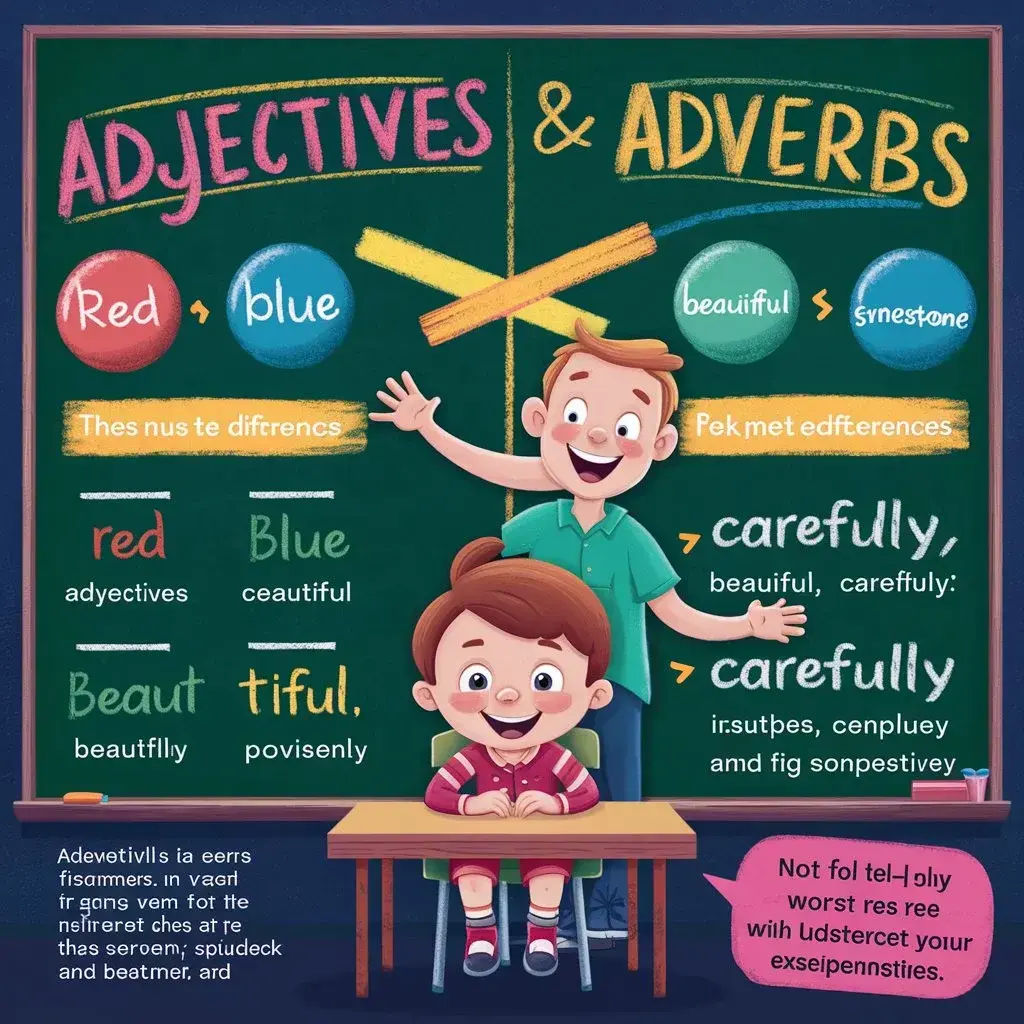In the realm of grammar, adjectives and adverbs play pivotal roles in shaping how we describe and articulate actions and qualities. Adjectives enrich our language by providing details about nouns and pronouns, such as colors (red, blue) or qualities (beautiful, intelligent). Meanwhile, adverbs modify verbs, offering insights into how actions are performed (quickly, carefully). While many adverbs typically end in -ly, it’s crucial to note exceptions where words ending in -ly function as adjectives instead.
Understanding these distinctions not only enhances our writing but also ensures clearer and more precise communication.
Adjectives And Adverbs
An adjective is a word that describes or modifies a noun or pronoun. It adds detail by specifying qualities, characteristics, or attributes.
Simple Examples of Adjectives:
- The big dog ran across the yard.
- She wore a red dress to the party.
- He is a kind person who helps others.
- The tall building stood against the skyline.
- We found a quiet place to study.
- Her beautiful voice captivated the audience.
- The old book was a valuable antique.
- They live in a cozy cottage by the lake.
- I prefer fresh fruit over canned.
- He gave a funny speech that made everyone laugh.
- She received a lovely bouquet of flowers.
- It was a hot summer day at the beach.
- The bright stars shone in the night sky.
- They were excited about their new house.
- He felt nervous before the exam.
An adverb is a word that modifies a verb, adjective, or another adverb. It provides more information about how, when, where, or to what extent something happens or is done.
Examples of Adverbs:
- She speaks fluently in several languages.
- They arrived early for the meeting.
- He runs quickly on the track.
- She sings beautifully in the choir.
- He works hard every day.
- They danced gracefully at the ball.
- The children played outside all afternoon.
- She smiled happily when she received the news.
- He drove carefully along the winding road.
- The rain fell heavily during the storm.
- He answered the question correctly during the quiz.
- They waited impatiently for the bus to arrive.
- The bird flew high into the sky.
- She spoke softly so as not to wake the baby.
- He studies efficiently to prepare for exams.
Spotting Adverbs
Spotting adverbs involves identifying words that modify verbs, adjectives, or other adverbs by providing additional information about how, when, where, or to what extent something happens or is done. Adverbs often end in -ly, but not always, as some adjectives also end in -ly. To determine if a word is an adverb, consider if it answers questions like how, when, where, or to what extent.
For example, in the sentence “She sings beautifully,” beautifully answers the question “how does she sing?” Adverbs play a crucial role in clarifying and enhancing the meaning of sentences by adding specific details about actions or qualities.
Words ending in –ly are not always Adverbs
- Friendly: “He gave me a friendly smile.” Here, friendly describes the nature of the smile, acting as an adjective modifying the noun smile.
- Lonely: “She felt lonely in the new city.” In this sentence, lonely describes the emotional state of the subject, acting as an adjective modifying the pronoun she.
- Early: “He arrived early for the meeting.” Here, early describes the time of arrival, acting as an adverb modifying the verb arrived.
- Costly: “This watch is quite costly.” In this sentence, costly describes the price of the watch, acting as an adjective modifying the pronoun this.
- Deadly: “The snake’s bite can be deadly.” Here, deadly describes the potential effect of the snake’s bite, acting as an adjective modifying the noun phrase snake’s bite.
Usage Notes
- There are specific cases in English grammar where using an adverb directly after certain verbs is considered incorrect or non-standard. These verbs include linking verbs such as feel, seem, look, appear, sound, taste, and smell. Instead of adverbs, it’s grammatically appropriate to use adjectives to describe the subject complement. Here are some examples:
- Linking Verb + Adjective:
- Correct: “She looks happy today.”
- Incorrect: “She looks happily today.”
- Linking Verb + Adjective:
- Correct: “The food tastes delicious.”
- Incorrect: “The food tastes deliciously.”
- Linking Verb + Adjective:
- Correct: “He seems tired after the long trip.”
- Incorrect: “He seems tiredly after the long trip.”
- Linking Verb + Adjective:
Identical Forms
Identical adjectives and adverbs are words that do not change their form when used to modify nouns or verbs. They serve the same function regardless of whether they are describing nouns or modifying verbs. Here are some examples of words that can function as both adjectives and adverbs without alteration:
Early:
Adjective: “This is an early train.”
Adverb: “The train came early today.”
Fast:
Adjective: “He drives a fast car.”
Adverb: “He drives fast on the highway.”
Late:
Adjective: “She was late for the meeting.”
Adverb: “She arrived late.”
Daily:
Adjective: “We receive daily updates.”
Adverb: “He exercises daily.”
Weekly:
Adjective: “They publish a weekly newsletter.”
Adverb: “They meet weekly to discuss.”
Monthly:
Adjective: “We review our monthly expenses.”
Adverb: “She pays her bills monthly.”
Yearly:
Adjective: “They hold a yearly conference.”
Adverb: “He visits his family yearly.”
Comparatives
The words “Most,” “More,” and “Less” serve as both adjectives when describing a noun and as adverbs when modifying a verb or adjective.
Most:
- Adjective:
- They have the most beautiful garden in the neighborhood.
- He owns the most expensive car on the street.
- This book is the most interesting one I’ve read.
- Adverb:
- She enjoys painting most on weekends.
- He talks most when he’s nervous.
- They play most competitively during tournaments.
More:
- Adjective:
- Can I have more cookies, please?
- We need to buy more groceries for the week.
- She wants more time to finish her project.
- Adverb:
- He needs to practice his piano lessons more often.
- Can you speak more quietly during the movie?
- They should exercise more regularly for better health.
Less:
- Adjective:
- She wants to eat less sugar to be healthier.
- They spent less money on their vacation this year.
- We have less time to prepare for the presentation.
- Adverb:
- He talks less frequently in group discussions.
- She drives less cautiously than before.
- They go out to eat less often now.
Good vs. Well:
Good is primarily used as an adjective to describe nouns. It indicates a positive quality or state.
Well is primarily used as an adverb to describe verbs. It indicates how an action is done or the state of being.
Examples of Good (Adjective):
- She baked a good cake for the party.
- He is a good student who always completes his assignments.
- They have a good time whenever they visit their grandparents.
- This movie has received good reviews from critics.
- We had a good laugh at his jokes.
- She has a good heart and helps others in need.
- He made a good impression at the job interview.
- It was a good decision to invest in that company.
- The weather looks good for our outdoor picnic.
- I have a good feeling about this project.
Examples of Well (Adverb):
- She speaks English well.
- He performs well under pressure.
- They danced well at the wedding.
- She plays the piano well.
- He knows the material well and can explain it clearly.
- The team worked well together to achieve their goals.
- She did well on her exam.
- He manages his time well.
- The car handles well on rough terrain.
- They communicate well with each other.
FAQs
Do we use adverbs before adjectives and adverbs?
Yes, adverbs can be used to modify both adjectives and other adverbs. For example:
- Adverb modifying an adjective: “She is very talented.”
- Adverb modifying another adverb: “He speaks quite softly.”
How do you teach the difference between adjectives and adverbs?
Teaching the difference between adjectives and adverbs involves explaining their roles:
- Adjectives describe nouns or pronouns (e.g., beautiful dress).
- Adverbs modify verbs, adjectives, or other adverbs (e.g., runs quickly).
What is the difference between an adverb and adjective? Is happy an adverb or adjective?
Between adverbs and adjectives, the key difference lies in their function:
- Adjectives describe nouns (e.g., happy child).
- Adverbs describe verbs, adjectives, or other adverbs (e.g., smiles happily).
How do you change adjectives into adverbs or adverbial phrases?
Most adverbs are formed by adding -ly to the adjective form (e.g., quick → quickly).
Adverbial phrases often involve using prepositions or combining adverbs with other words (e.g., in a hurry, very slowly).
What is the correct order of adverbs?
Adverbs typically follow a specific order when multiple adverbs modify the same verb:
- Manner (how): She speaks softly.
- Place (where): He lives nearby.
- Time (when): They arrived early.
- Frequency (how often): He exercises daily.
- Purpose (why): She studies hard to pass the exam.
- Degree (to what extent): He is very happy.
How do you use adjectives and adverbs together?
Adjectives and adverbs can be used together to provide more precise descriptions:
- Adverb modifying an adjective: “She is extremely beautiful.”
- Adjective modifying a noun and adverb modifying a verb: “He drives a fast car and drives carefully.”
What is the rule of adverbs?
Adverbs modify verbs, adjectives, or other adverbs to provide more information about how, when, where, or to what extent an action occurs.
What is the rule to form adverbs?
The most common way to form adverbs is by adding -ly to the adjective form (e.g., quick → quickly). However, there are exceptions and irregular adverbs that do not follow this rule (e.g., well).
Final tips
In conclusion, mastering the use of adjectives and adverbs is essential for clear and effective communication in English. Adjectives enrich our language by describing nouns and pronouns, while adverbs provide additional details about verbs, adjectives, or other adverbs. Understanding when to use each, whether it’s to specify qualities (beautifully written), actions (ran quickly), or states (very tired), ensures that your writing and speech are precise and impactful. By following the rules and patterns of adverb formation, such as adding -ly to adjectives in most cases, you can confidently express yourself with clarity and nuance.
In summary, understanding the nuances between adjectives and adverbs enhances clarity and precision in your English communication.

I’m Clara Whitmore, the girl running the show at “Grammer Grove.” I’ve been playing with expressions and formats to make grammer a whole lot of fun. Over at Grammer grove, we’re here to make your English grammer incredible. Let’s add some professionalism and gratitude to yourwritting together!












